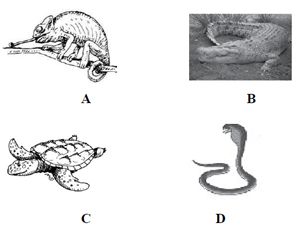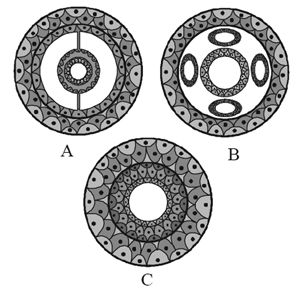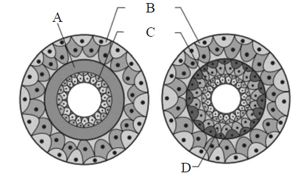Which of the following sets of animals give birth to young ones?
Platypus, Penguin, Bat, Hippopotamus.
Shrew, Bat, Cat, Kiwi.
Kangaroo, Hedgehog, Dolphin, Loris.
Lion, Bat, Whale, Ostrich.
Correct Answer :
C. Kangaroo, Hedgehog, Dolphin, Loris.
Penguin, kiwi and ostrich all belongs to class Aves (i.e. birds) of chordata and they do not give birth to their young ones, they are oviparous while kangaroo, hedgehog, dolphin and loris, all belong to class mammalia and are viviparous.
Related Questions
Which of the following statement(s) is/are correct for class amphibia?
(i) Body is divisible into head and trunk.
(ii) Respiration is through gills only.
(iii) The heart is two chambered i.e. one auricle and one ventricle.
(iv) Fertilization is internal.
Only (i)
Only (iv)
(i), (ii) and (iii)
All of these
Refer the following statement and answer the question. 'Name of X is derived from stinging capsules. It exhibits metagenesis containing two body forms in which sessile and cylindrical form is called Y and umbrella shaped and free swimming is called Z. Identify X, Y, and Z.
X - Coelenterate, Y - Polyp, Z - Medusa
X - Cnidarian, Y - Medusa, Z - Polyp
X - Ctenophora, Y - Radula, Z - Hypostome
X - Porifera, Y - Osculum, Z - Radula
Read the following statements and answer the question.
(i) They are exclusively marine, radially symmetrical, diploblastic organisms with tissue level of organisation.
(ii) Body bears eight external rows of ciliated comb plates, which help in locomotion.
(iii) Digestion is both extracellular and intracellular.
(iv) Reproduction takes place only by sexual means.
Which of the following phylum is being described by above statements?
Platyhelminthes
Arthropoda
Mollusca
Ctenophora
The given figures A, B, C and D are the examples of first true land vertebrates. They are dominant in mesozoic era and belong to phylum ‘X’. Identify ‘X’ and the animals which have four chambered heart.

X – Reptile; B
X – Reptile; A
X – Amphibia, C
X – Pisces; D
Which of the following is not a chordate character?
Presence of paired pharyngeal gill slits
Ventral heart
Solid and ventral nerve cord
Presence of post-anal tail
Match the characteristic feature/terms given in column I with the phylum to which they belongs given in column II and choose the correct option.
| Column-I | Column-II |
|---|---|
| (Characteristic feature/term) | (Phylum) |
| A. Choanocytes | I. Platyhelminthes |
| B. Cnidoblasts | II. Ctenophora |
| C. Flame cells | III. Porifera |
| D. Nephridia | IV. Coelenterata |
| E. Comb plates | V. Annelida |
A II; B I; C IV; D V; E III
A II; B IV; C I; D V; E III
A V; B I; C III; D II; E IV
A III; B IV; C I; D V; E II
Match the phylum given in column - I with their example given in column - II and choose the correct option.
| Column -I | Column- II |
|---|---|
| (Phylum) | (Examples) |
| A. Echinodermata | I. Ascidia, Doliolum |
| B. Hemichordata | II. Asterias, Ophiura |
| C. Urochordata | III. Branchiostoma |
| D. Cephalochordata | IV. Balanoglossus, Saccoglossus |
A IV; B II; C I; D III
A II; B IV; C I; D III
A II; B IV; C III; D I
A II; B I; C IV; D III
A common characteristic of all vertebrates without exception is
the division of body into head, neck, trunk and tail.
body covered with exoskeleton.
the possession of two pairs of functional appendages.
the presence of well- developed skull.
Which one of the following features is common in silverfish, scorpion, dragonfly and prawn?
Three pairs of legs and segmented body.
Chitinous cuticle and two pairs of antennae.
Jointed appendages and chitinous exoskeleton.
Cephalothorax and tracheae.
Which of the following is a fresh water sponge?
Sycon
Euspongia
Spongilla
Pleurobrachia
When any plane passing through the central axis of the body divides the organism into two identical halves, the organism is called ___________.
radially symmetrical
bilaterally symmetrical
asymmetrical
metamerically segmented
Select the incorrect feature of mollusca from the given statements.
- Terrestrial or aquatic animals having cellular system level of organization.
- Radial symmetrical and acoelomate animals and possesses two germinal layers.
- A file like rasping organ called radula is present.
- Usually dioecious and viviparous animals.
- Examples include Pila, Octopus, and Dentalium.
(i) and (ii) only
(ii) and (iv) only
(i), (ii) and (iv) only
All the five statements.
Which of the following statements (i – v) are incorrect ?
- Circulatory system in arthropods is of closed type.
- Parapodia in annelids helps in swimming.
- Phylum mollusca is the second largest animal phylum.
- Aschelminthes are dioecious.
(i) only
(iii) only
(i) and (iii)
(iii) and (iv)
Heart is three - chambered in reptiles, except
turtle
Chameleon
Naja (Cobra)
crocodile
Which of the following is an incorrect statement regarding flatworms ?
They are acoelomates.
They are bilaterally symmetrical.
They lack a digestive system.
They have a circulatory system.
Refer the figures A, B, C and D given below. Which of the following options shows the correct name of the animals shown by the figures A, B, C and D ?

A – Locust, B – Scorpion, C – Prawn, D – Pila
A – Locust, B – Prawn, C – Scorpion, D – Pila
A – Locust, B – Scorpion, C – Prawn, D – Snail
A – Butterfly, B – Scorpion, C – Prawn, D – Pila
In phylum echinodermata, the adult echinoderms are ______A__________ but larvae are _______B______ .
A radially symmetrical; B bilaterally symmetrical
A bilaterally symmetrical; B radially symmetrical
A bilaterally symmetrical; B asymmetrical
A metamerically segmented; B asymmetrical
Identify the correct characteristic feature shown by the given figure?

Diploblastic in nature.
Having radial symmetrical body.
Dioecious with direct development.
Presence of sensory tentacles on anterior head region.
Which of the following traits is not shared by both sea anemones and jellyfish ?
A medusa as the dominant stage in the life cycle.
Possession of a gastro vascular cavity.
Sexual reproduction.
Nematocysts present on the tentacles.
Column-I contains organisms and column-II contains their exeretory structures. Choose the correct match form the options given below.
| Column- I | Column -II |
|---|---|
| (Organism) | (Excretory structures) |
| A. Cockroach | I. Nephridia |
| B. Cat fish | II. Malpighian tubules |
| C. Earthworm | III. Kidneys |
| D. Balanoglossus | IV. Flame cells |
| E. Flatworm | V. Proboscis gland |
A I; B III; C II; D IV; E V
A III; B I; C II; D V; E IV
A II; B I; C III; D V; E IV
A II; B III; C I; D V; E IV
Which one of the following statement regarding coelom of given animals is correct?
Round worms (aschelminthes) are pseudocoelomates.
Molluscs are acoelomates.
Insects are pseudocoelomates.
Flatworms (platyhelminthes) are coelomates.
Identify the figures and select the correct option

A - Pseudocoelomate; B - Coelomate, C-Acoelomate
A - Coelomate, B - Pseudocoelomate, C- Acoelomate
A - Coelomate; B- Acoelomate; C - Pseudocoelomate
A - Coelomate; B- Acoelomate; C-Eucoelomate
The combination of a true coelom and repeating body segmentation allows the annelids (unlike the anatomically simpler worms) to do which of the following?
Attain complex body shapes and thus locomote more precisely.
Move through loose marine sediments.
Be hermaphroditic.
Inject paralytic poisons into their prey.
Polyp phase is absent in
Hydra
Aurelia
Physalia
Obelia
The figure given below shows the germinal layers marked as A, B, C and D. Identify the label showing undifferentiated layer and its location?

A, Between B & C
B, Between A & C
C, Between C & D
D, Between A & B
Which of the following statements (i v) are incorrect?
(i) Parapodia are lateral appendages in arthropods used for swimming.
(ii) Radula in molluscs are structures involved in excretion.
(iii) Aschelminthes are dioecious.
(iv) Echinoderm adults show radial symmetry.
(v) Ctenophorans are diploblastic.
(i) and (ii)
(i) and (iii)
(i), (iv) and (v)
(iii) and (v)
Match the types of animals given in column I with their examples given in column II and choose the correct option.
| Column -I | Column -II |
|---|---|
| (Types of animals) | (Examples) |
| A. Limbless reptiles | I. Elephant |
| B. Jawless vertebrates | II. Lamprey |
| C. Flightless bird | III. Ichthyophis |
| D. Largest | IV. Ostrich terrestrial animal |
| E. Limbless amphibia | V. Cobra |
A II; B V; C IV; D I; E III
A V; B II; C IV; D I; E III
A V; B II; C I; D IV; E III
A V; B IV; C II; D I; E III
Refer the following animals and identify those which have a fluid filled body cavity with a complete lining derived from mesoderm.
(i) Sycon (ii) Butterfly
(iii) Nereis (iv) Sea fan
(v) Scorpion (vi) Pila
(i) and (iii) only
(ii) and (iv) only
(ii), (iii), (v) and (vi) only
All of these
Which one of the following categories of animals is correctly described with no single exception in it?
In chondrichthyes notochord is persistent throughout life.
All mammals are viviparous and possess diaphragm for breathing.
All sponges are marine.
All reptiles possess scales, have a three chambered heart and are cold blooded (poikilothermal).
Identify the correct characteristics of porifera.
- Commonly known as sea walnuts.
- Presence of ostia and collar cells.
- Exhibit tissue level of characteristics.
- It is the largest phylum of animal kingdom.
- The body is supported by spicules and sponging fibers.
- Contains cnidocytes which is used for defense, anchorage and capturing of prey.
(ii), (v) only
(i), (ii), (vi) only
(i), (ii), (iii), (iv) only
All of these.
